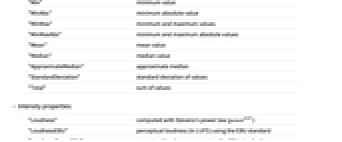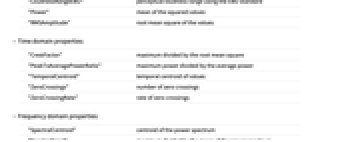AudioMeasurements[audio,"prop"]
computes the property "prop" for the entire audio.
AudioMeasurements[audio,{"prop1","prop2",…}]
computes several properties "propi".
AudioMeasurements[audio,"prop",format]
returns the values in the specified output format.
AudioMeasurements[{audio1,audio2,…},…]
returns measurements for all audioi.
AudioMeasurements[video,…]
returns measurements for the first audio track in video.


AudioMeasurements
AudioMeasurements[audio,"prop"]
computes the property "prop" for the entire audio.
AudioMeasurements[audio,{"prop1","prop2",…}]
computes several properties "propi".
AudioMeasurements[audio,"prop",format]
returns the values in the specified output format.
AudioMeasurements[{audio1,audio2,…},…]
returns measurements for all audioi.
AudioMeasurements[video,…]
returns measurements for the first audio track in video.
Details and Options



- AudioMeasurements[audio,"Properties"] gives names of all available properties as a list of strings.
- Global audio properties:
-
"Channels" number of channels "Duration" duration "Length" number of samples "SampleRate" sample rate in Hz "Type" data type - All of the following properties are computed on the average channel values.
- Basic histogram properties:
-
"Max" maximum value "MaxAbs" maximum absolute value "Min" minimum value "MinAbs" minimum absolute value "MinMax" minimum and maximum values "MinMaxAbs" minimum and maximum absolute values "Mean" mean value "Median" median value "ApproximateMedian" approximate median "StandardDeviation" standard deviation of values "Total" sum of values - Intensity properties:
-
"Loudness" computed with Stevens's power law (  )
)"LoudnessEBU" perceptual loudness (in LUFS) using the EBU standard "LoudnessRangeEBU" perceptual loudness range using the EBU standard "Power" mean of the squared values "RMSAmplitude" root mean square of the values - Time domain properties:
-
"CrestFactor" maximum divided by the root mean square "PeakToAveragePowerRatio" maximum power divided by the average power "TemporalCentroid" temporal centroid of values "ZeroCrossings" number of zero crossings "ZeroCrossingRate" rate of zero crossings - Frequency domain properties:
-
"SpectralCentroid" centroid of the power spectrum "SpectralCrest" maximum divided by the mean of the power spectrum "SpectralFlatness" geometric mean divided by the mean of the power spectrum "SpectralKurtosis" kurtosis of the magnitude spectrum "SpectralRollOff" frequency below which most of the energy is concentrated "SpectralSkewness" skewness of the magnitude spectrum "SpectralSlope" estimated slope of the magnitude spectrum "SpectralSpread" measure of the bandwidth of the power spectrum - By default, a list of property values is returned. Other format specifications include:
-
Automatic determine the output automatically "Association" format the result as an Association "Dataset" format the result as a Dataset "List" format the result as a List "RuleList" format the result as a list of Rule expressions
Examples
open all close allBasic Examples (2)
Scope (4)
Compute several properties on multiple audio objects:
Format the output as an Association:
Return a Dataset:
In multichannel audio objects, the channels are averaged before the computation of the properties:
Applications (2)
Properties & Relations (4)
Functions like Min applied to multichannel audio work on flattened data:
AudioMeasurements works on the mono version of the input audio signal:
The "LoudnessEBU" is computed according to the integrated loudness EBU specification:
The loudness is computed using the EBU momentary specification:
A temporary mean is computed by discarding all values below ![]() LUFS:
LUFS:
Another mean is computed by excluding all values below the temporary mean minus 10 LUFS:
The "LoudnessRangeEBU" is computed according to the integrated loudness EBU specification:
The loudness is computed using the EBU momentary specification:
First, a temporary mean is computed by discarding all values below ![]() LUFS:
LUFS:
Then all values below the temporary mean minus 20 LUFS are excluded:
The loudness is computed as the difference between the .1 and .95 quantiles of the list:
The "LoudnessEBU" property is used in the computation of AudioNormalize:
Related Guides
Text
Wolfram Research (2016), AudioMeasurements, Wolfram Language function, https://reference.wolfram.com/language/ref/AudioMeasurements.html (updated 2024).
CMS
Wolfram Language. 2016. "AudioMeasurements." Wolfram Language & System Documentation Center. Wolfram Research. Last Modified 2024. https://reference.wolfram.com/language/ref/AudioMeasurements.html.
APA
Wolfram Language. (2016). AudioMeasurements. Wolfram Language & System Documentation Center. Retrieved from https://reference.wolfram.com/language/ref/AudioMeasurements.html
BibTeX
@misc{reference.wolfram_2025_audiomeasurements, author="Wolfram Research", title="{AudioMeasurements}", year="2024", howpublished="\url{https://reference.wolfram.com/language/ref/AudioMeasurements.html}", note=[Accessed: 03-January-2026]}
BibLaTeX
@online{reference.wolfram_2025_audiomeasurements, organization={Wolfram Research}, title={AudioMeasurements}, year={2024}, url={https://reference.wolfram.com/language/ref/AudioMeasurements.html}, note=[Accessed: 03-January-2026]}